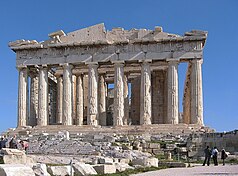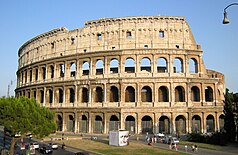
Back Klassieke Oudheid Afrikaans Antike ALS كلاسيكية قديمة Arabic Antigüedá clásica AST Antik Azerbaijani Антиклыҡ Bashkir Antike BAR Антычнасць Byelorussian Антычнасьць BE-X-OLD Античност Bulgarian
| Part of a series on |
| Classicism |
|---|
 |
| Classical antiquity |
| Age of Enlightenment |
| 20th-century neoclassicism |
| Part of a series on |
| Human history |
|---|
| ↑ Prehistory (Stone Age) (Pleistocene epoch) |
| ↓ Future |
Classical antiquity, also known as the classical era, classical period, classical age, or simply antiquity,[1] is the period of cultural European history between the 8th century BC and the 5th century AD[note 1] comprising the interwoven civilizations of ancient Greece and ancient Rome known together as the Greco-Roman world, centered on the Mediterranean Basin. It is the period during which ancient Greece and ancient Rome flourished and had major influence throughout much of Europe, North Africa, and West Asia.[2][3]
Conventionally, it is often considered to begin with the earliest recorded Epic Greek poetry of Homer (8th–7th-century BC) and ends with the end of the Western Roman Empire in 476 AD. Such a wide span of history and territory covers many disparate cultures and periods. Classical antiquity may also refer to an idealized vision among later people of what was, in Edgar Allan Poe's words, "the glory that was Greece, and the grandeur that was Rome".[4]
The culture of the ancient Greeks, together with some influences from the ancient Near East, was the basis of art,[5] philosophy, society, and education in the Mediterranean and Near East until the Roman imperial period. The Romans preserved, imitated, and spread this culture throughout Europe, until they were able to compete with it.[6][7] This Greco-Roman cultural foundation has been immensely influential on the language, politics, law, educational systems, philosophy, science, warfare, literature, historiography, ethics, rhetoric, art and architecture of both the Western, and through it, the modern world.[8]
Surviving fragments of classical culture helped produce a revival beginning during the 14th century which later came to be known as the Renaissance, and various neo-classical revivals occurred during the 18th and 19th centuries.[9][10]
- ^ Gruen, E. (2010). Rethinking the Other in Antiquity. Princeton University Press. doi:10.1515/9781400836550. ISBN 9781400836550.
- ^ McLaughlin, Raoul (11 September 2014). The Roman Empire and the Indian Ocean: The Ancient World Economy and the Kingdoms of Africa, Arabia and India. Pen & Sword. ISBN 9781473840959.
- ^ McLaughlin, Raoul (11 November 2016). The Roman Empire and the Silk Routes: The Ancient World Economy & the Empires of Parthia, Central Asia & Han China. Pen & Sword. ISBN 9781473889811.
- ^ Poe EA (1845). "To Helen#Revised 1845 version".
- ^ Helga von Heintze [de]: Römische Kunst (Roman art). In: Walter-Herwig Schuchhardt (1960): Bildende Kunst I (Archäologie) (Visual arts I – archaeology). Das Fischer Lexikon [de]. S. Fischer Verlag. p. 192. "Bestimmend blieb (...) der italisch-römische Geist, der sich der entlehnten Formen nur bediente. (...) Ohne [die] Begegnung [mit der griechischen Formenwelt, author's note] hätte der italisch-römische Geist sich wohl kaum in künstlerischen Schöpfungen ausdrücken können und wäre nicht über die Ansätze, die wir in den Kanopen von Chiusi (...), der kapitolinischen Wölfin (...), dem Krieger von Capestrano (...) erhalten haben, hinausgekommen. Auch die gleichermaßen realistische wie unkünstlerische Auffassung der Porträts im 2. und 1. J[ahr]h[undert] v[or] Chr[istus] konnte sich nur unter dem Einfluß griechischer Formen ändern." ("Determinant remained the Italic-Roman spirit, that just availed itself of the borrowed forms. (...) Without having come across [the world of the Greek forms], the Italic–Roman spirit would hardly have been able to express itself in works of art and would not have got beyond the starts that are preserved in the canopic jars of Chiusi, the Capitoline Wolf, the Warrior of Capestrano. Also the likewise realistic and inartistic conception and production of the portraits in the second and the first centuries BC could only change under the influence of Greek forms.")
- ^ Der Große Brockhaus. 1. vol.: A-Beo. Eberhard Brockhaus, Wiesbaden 1953, p. 315. "Ihre dankbarsten und verständnisvollsten Schüler aber fand die hellenistische Kultur in den Römern; sie wurden Mäzene, Nachahmer und schließlich Konkurrenten, indem sie die eigene Sprache wetteifernd neben die griechische setzten: so wurde die antike Kultur zweisprachig, griechisch und lateinisch. Das System dieser griechisch-hellenistisch-römischen Kultur, das sich in der römischen Kaiserzeit abschließend gestaltete, enthielt, neben Elementen des Orients, die griechische Wissenschaft und Philosophie, Dichtung, Geschichtsschreibung, Rhetorik und bildende Kunst." ("The Hellenistic culture but found its most thankful and its most understanding disciples in the Romans; they became patrons, imitators, and finally rivals, when they competitively set the own language beside the Greek: thus, the antique culture became bilingual, Greek and Latin. The system of this Greco-Latin culture, that assumed its definitive shape in the Roman imperial period, contained, amongst elements of the Orient, the Greek science and philosophy, poetry, historiography, rhetoric and visual arts.")
- ^ Veit Valentin: Weltgeschichte – Völker, Männer, Ideen (History of the world – peoples, men, ideas). Allert de Lange [de], Amsterdam 1939, p. 113. "Es ist ein merkwürdiges Schauspiel – dieser Kampf eines bewussten Römertums gegen die geriebene Gewandtheit des Hellenismus: der römische Geschmack wehrt sich und verbohrt sich trotzig in sich selbst, aber es fällt ihm nicht genug ein, er kann nicht über seine Grenzen weg; was die Griechen bieten, hat soviel Reiz und Bequemlichkeit. In der bildenden Kunst und in der Philosophie gab das Römertum zuerst den Kampf um seine Selbständigkeit auf – Bilden um des Bildes willen, Forschen und Grübeln, theoretische Wahrheitssuche und Spekulation lagen ihm durchaus nicht." ("It is a strange spectacle: this fight of a conscious Roman striving against the wily ingenuity of Hellenism. The Roman taste offers resistance, defiantly goes mad about itself, but there does not come enough into its mind, it is not able to overcome its limits; there is so much charm and so much comfort in what the Greeks afford. In visual arts and philosophy, Romanism first abandoned the struggle for its independence – forming for the sake of the form, poring and investigation, theoretical speculation and hunt for truth were by no means in its line.")
- ^ "Traces of Ancient Rome in the Modern World". education.nationalgeographic.org. Retrieved 30 July 2023.
- ^ "Neoclassical architecture | Definition, Characteristics, Examples, & Facts | Britannica". Encyclopædia Britannica. 1 June 2023. Retrieved 30 July 2023.
- ^ "Classical / Classical Revival / Neo-Classical: an architectural style guide". architecture.com. Retrieved 30 July 2023.
Cite error: There are <ref group=note> tags on this page, but the references will not show without a {{reflist|group=note}} template (see the help page).

